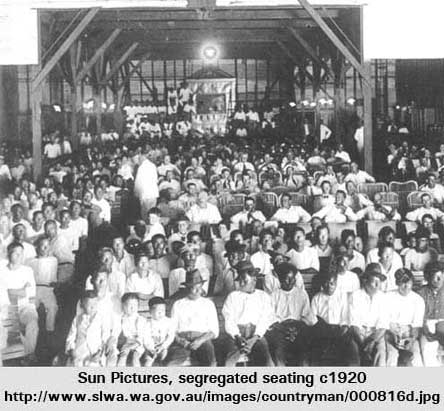Yejiro Yamasaki in 1903 purchased the land where the Sun Pictures building in Broome’s Chinatown still stands. He built an Asian Emporium selling picture postcards, foodstuffs, clothing and household goods imported from Japan. The Yamasakis were avid theatre enthusiasts and part of the building housed a traditional Japanese playhouse. Some time around late 1910 the Yamasakis left Broome for Singapore. [1]
In 1913, the land and building was sold to Edmund Harold Hunter, a master pearler, who redesigned it as a picture theatre with three sides under a high–pitched twin–peaked roof; the fourth side open to the screen and the elements.[2] Sun Pictures was officially opened on 9 December 1916. It is the oldest picture gardens in the world still in operation. Before a levee bank was built across the marsh in 1974 the theatre (and the town) was continually inundated by tidal flooding. [3]

From the opening night seats were allocated strictly according to race. Under cover canvas and cane chairs with cushions were reserved for the worthiest of the white Europeans; deck chairs for the Asian merchants, divers and the acculturated mixed–race population; fold-up chairs and benches for the children. Lugger crews, including Malays, Koepangers, Filipinos and Aborigines, entered through a separate door and had to sit in an area separated by a lattice dividing rail, or on the benches outside and to the front of the Europeans, or in stadium-type seating at the very back. Europeans, Japanese and Chinese paid two shillings and sixpence for entry. Those who entered through the second main door paid one shilling and sixpence if Asian or one shilling if Aboriginal. Children of all colours paid sixpence.[4]
Susan Sickert in Beyond the Lattice notes that during the time when Sun Pictures was owned by Walter Anderson (1948–53) many local mixed–race families, fed up with the racially discriminating seating, boycotted the Sun Picture Gardens for several picture show nights. Sickert explains:
“Although greater seating choices were noticeable after the boycott it was only in 1975 that segregation according to race became illegal. Seating then finally became a matter of choice for all and the hierarchy of comfort was no longer a tool of discrimination against the non–white population as they sat down to be entertained at the movies.” [5]
No doubt on the night of the 2008 Shinju Filipino Festival held in the Sun Picture Gardens the ghosts of the master pearlers and their lady wives would be scandalised to see the place packed out with Aborigines, Europeans and Asians of all variety and relationship, dancing, drinking, eating Filipino food and having a really great time together.
A remarkable presentation at this year’s Shinju functions was the Bao Dancers, a new group who started rehearsing only three weeks before opening night. The Maglalatik, originally performed in Laguna, is a mock war dance depicting a legendary fight between the Moros and the Christians over the latik (residue left after the coconut milk has been boiled). These guys were so popular that they were called on twice for repeat performances — “Five Filipino men without shirts wearing coconuts? Yes!” And you too can enjoy Maglalatik in Broome on YouTube at this Internet address http://au.youtube.com/watch?v=ao3fLf2irDY.
On the eve of the Shinju Matsuri Float Parade Sam Fronda and Henry Babaran, two of the Bao Dancers, came to Kevin Puertollano’s house to help mount the cardboard fish and pictures onto the fishtrap wire. A few weeks before and again after the festival, they were all part of a beach gathering of Broome people with Filipino ancestry — fate and the ‘tides’ indeed brought them all to the shores of Broome. By the Old Jetty site at Town Beach where the various groups met twice, their exchange of stories brought them closer together.
Kasama editor Dee Hunt and writer Deborah Ruiz Wall who were there to witness their historic salu–salos (gatherings around food) equally want to pay tribute to our kababayan (compatriots) and Aboriginal–Filipino countrymen for receiving us with warmth, generosity and hospitality. We also want to thank Goolarri Media Enterprises (GME), Kimberley Stolen Generation (KSG), and the University of Notre Dame staff for the attention and assistance they have given us. We will always treasure our marvellous time in Broome.
See also:
 Home | Aims and Objectives of Solidarity Philippines Australia Network | About Kasama
Home | Aims and Objectives of Solidarity Philippines Australia Network | About Kasama 
Search the SPAN Web